I recently moved into a new apartment, which means I’ve been buying a lot of stuff: a vacuum, a couch, a desk, and so many shelves. Why do I feel the need to buy things, anyway? As a psychology major, all of this made me wonder about the external and subconscious factors influencing my purchasing decisions, and the answer lies in consumer behavior models.
Understanding consumer behavior is crucial for business success. If you want to sell to customers, you need to know how and why they buy. By diving into consumer behavior models, you can uncover how, when, and why customers make purchase decisions. With this knowledge, you can meet the right customers with the right messages at the right time.
In this post, I’ll discuss the most important consumer behavior models and share how you can use them to create customer-centric experiences.
Table of Contents
- What Are Consumer Behavior Models?
- Consumer Behavior Models
- Choosing the Right Model for Your Business
.webp)
Free Customer Journey Template
Outline your company's customer journey and experience with these 7 free templates.
- Buyer's Journey Template
- Future State Template
- Day-in-the-Life Template
- And more!
Download Free
All fields are required.
.webp)
What Are Consumer Behavior Models?
A consumer behavior model is a theoretical framework that explains why and how customers make purchasing decisions. A consumer behavior model aims to outline a predictable map of customer decisions up until conversion, helping you drive every stage of the buyer’s journey.
Consumer behavior models may sound complicated, but I’ve actually found them quite intuitive. They allow you to create a “buyer behavior story” to refine and improve your customer experience.
Buyer behavior refers to an individual's buying habits, which are influenced by their background, education, personal beliefs, goals, needs, desires, and more. For example, my personal belief is that I need a little sweet treat after every meal (kidding … but not really).
Businesses aim to understand buyer behavior through customer behavior analysis, which involves qualitative and quantitative analysis of a target market. Even though this data can tell you your customer’s favorite brand of socks, it doesn’t mean much if it doesn’t tell you why they purchased that brand of socks.
That’s where consumer behavior models come in. Consumer behavior models contextualize results from customer behavior analysis and help you understand the “why” of purchasing decisions.
Consumer Behavior Models
Customer behavior models help you understand your unique customer base and attract, engage, and retain them more effectively. Consumer behavior models are separated into two categories: traditional and contemporary.
|
Traditional Consumer Behavior Models |
Contemporary Consumer Behavior Models |
|
Learning Model |
Engel-Kollat-Blackwell (EKB) Model |
|
Psychoanalytical Model |
Black Box Model |
|
Sociological Model |
Hawkins Stern Model |
|
Economic Model |
Howard Sheth Model |
|
Nicosia Model |
|
|
Webster and Wind Model |
Traditional Behavior Models
Traditional behavior models were developed by economists hoping to understand what customers purchase based on their wants and needs. Traditional models include the following:
- Learning Model
- Psychoanalytical Model
- Sociological Model
- Economic Model
I’ll take you through each.
1. Learning Model of Consumer Behavior
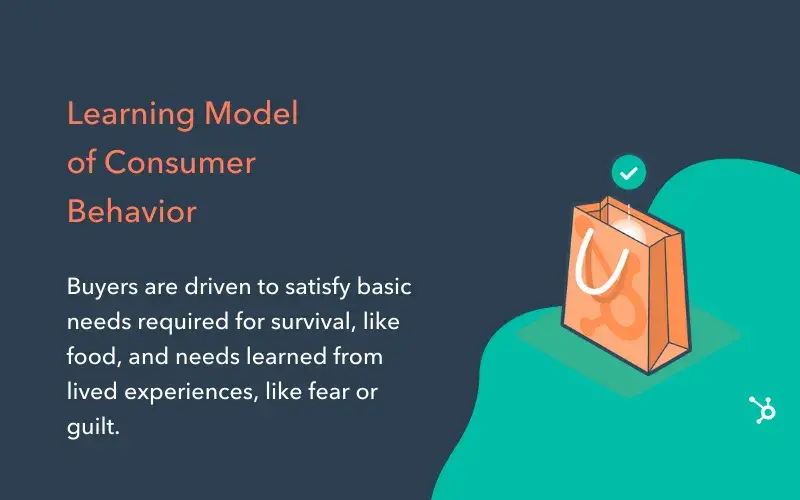
The Learning Model of Consumer Behavior postulates that purchase decisions are driven by the desire to fulfill basic needs (food, shelter, clothing), followed by needs learned from lived experiences. I like to think of it as Maslow’s Hierarchy of Needs (pictured below) but for capitalism:
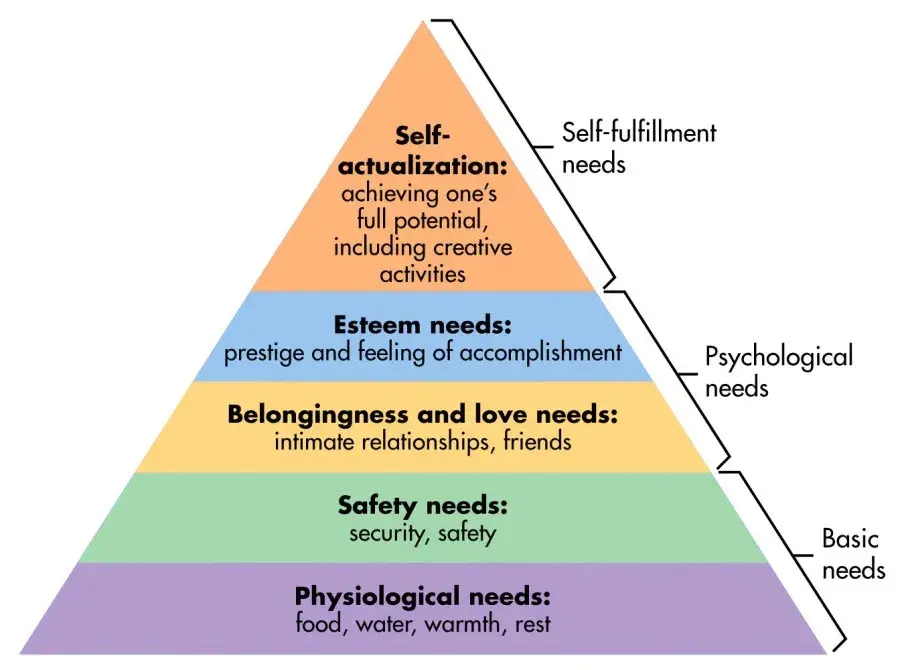
Basic needs like food and shelter are at the base of Maslow’s pyramid. As we ascend, we encounter learned psychological needs from experiences, such as self-esteem and accomplishment.
For instance, when I’m hungry, I need to buy food. My basic need for food drives me to purchase food at a restaurant or grocery store. I can buy basic groceries like milk, eggs, and produce, or I can decide to dine at a trendy restaurant. Discretionary purchases like dining out at fancy restaurants fulfill a higher need, perhaps learned, to satisfy psychological needs of esteem and prestige.
Does this model apply to your business?
A business that offers products that meet various levels of needs will take advantage of the Learning Model of Consumer Behavior. For example, a grocery store greets you with essentials like fresh produce before leading you to premium and discretionary items. I fall victim to the Learned Model whenever I go to Whole Foods for veggies and then grab an adaptogenic reishi mushroom chocolate milk elixir at checkout.
2. Psychoanalytical Model of Consumer Behavior
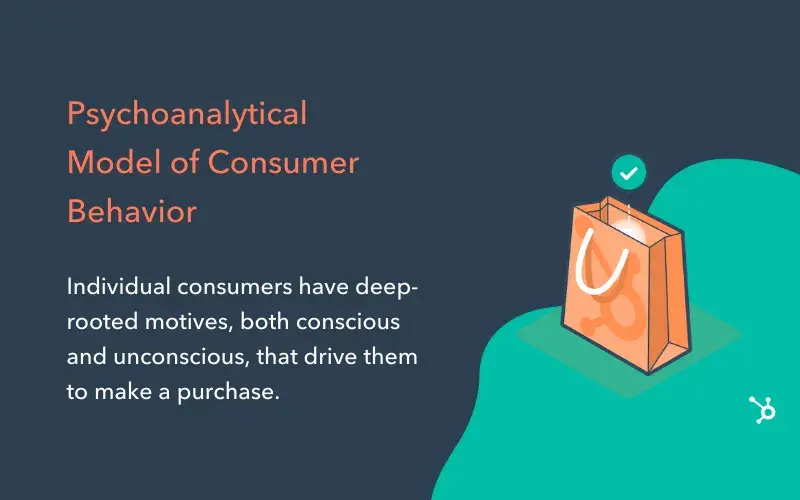
The Psychoanalytical Model draws from Sigmund Freud’s theories of psychoanalysis. This consumer behavior model suggests that individual consumers are driven by deeply rooted conscious and subconscious desires. According to this theory, consumers may be drawn to particular products or brands without fully understanding why.
If you’re a ‘90s kid like me, you probably fondly remember Altoids Sours. Well, I have good news — they’re back, and I’ll be picking up a tin. However, I’m not just buying them because they taste good. According to the psychoanalytical model, nostalgia products like Altoids Sours fulfill a psychological desire to return to the safety and simplicity of childhood. This subconscious longing drives my purchasing decision, even if I’m unaware of it.
Does this model apply to your business?
Businesses that sell an image or lifestyle might be suited to the psychoanalytical model. For example, luxury fashion brands aren’t just selling clothes but fulfilling a deep-seated desire for status and prestige.
3. Sociological Model

The Sociological Model of Consumer Behavior explores how societal factors and group influences shape individual purchasing decisions. Unlike psychological models that focus on subtle internal motivations, the sociological model emphasizes the broader social context in which we operate, where the pressure to conform influences our decisions as consumers.
We belong to many groups at once, which can be demarcated by social roles, preferences, cultural trends, friends and family, age range, and more.
For instance, I am a:
- Millennial
- College Graduate
- Professional Bassist
- New Yorker
These are examples of social groups I belong to that marketers can target with messaging and strategies that resonate with me and others in those groups.
As a bassist, many of my favorite players played Fender basses. Pino Palladino, James Jamerson, and Flea, just to name a few. As you may have guessed, I’m a Fender bass guy. The sociological model of consumer behavior would postulate that the preferences of my favorite bassists influenced me in an aspirational attempt to belong to the same group, and well, I’d have to say that’s accurate, which brings me to my next point:
.png)
How to Use Psychology in Marketing
Access the guide to learn more about psychology.
- Turn customers into fans.
- Understand Maslow's hierarchy of human needs.
- Understand how marketing can influence how people think, feel, and behave.
Download Free
All fields are required.
.png)
Reference Groups
Reference groups are groups people look up to for guidance or aspire to belong to. Like I aspired to belong to the group of legendary Fender bassists, many of today’s consumers look to social media influencers who set trends in fashion, tech, and beyond, driving billions of dollars of consumer spending.
Does this model apply to your business?
Probably, yes. In my view, almost any business can tap into the sociological model of consumer behavior to drive sales. The key is identifying your niche and positioning your product as a way for consumers to align themselves with a social group they value.
4. Economic Model of Consumer Behavior
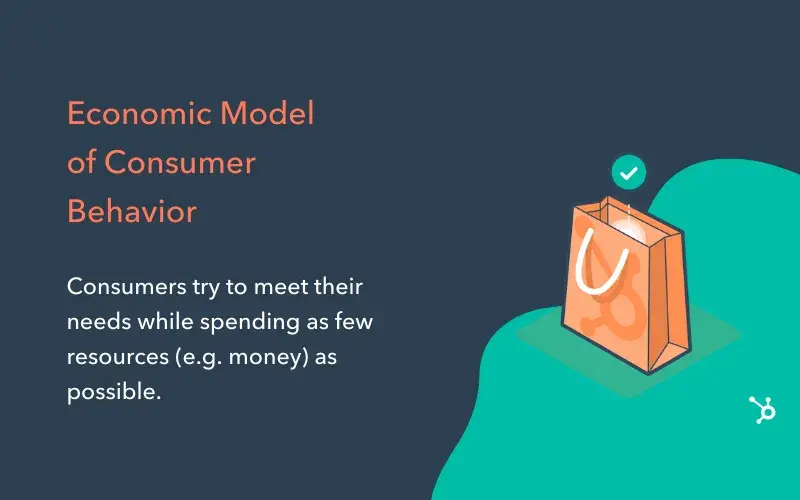
The Economic Model of Consumer Behavior is rooted in rational choice theory, which assumes that consumers will make decisions to maximize utility (satisfaction) while minimizing costs (money, time, effort).
The economic model takes a logical approach to consumer behavior, which is valid but also neglects the emotional and psychological influences referenced in other traditional models.
The economic model of consumer behavior is predicated on a few assumptions:
- Rational Decision-Making. Consumers are rational actors who evaluate the costs and benefits of each purchase.
- Budget Constraints. Consumers have limited resources and will try to spend within their budget.
- Price Sensitivity. Price is the primary factor influencing consumer decisions. If the price decreases, consumers will buy more, and vice versa.
- Perfect Information. This model assumes consumers have full market knowledge regarding prices and alternatives.
- Income Effects. Consumers will buy more as their income increases, and vice versa, save for inferior goods that increase in demand as consumer income decreases.
- Substitutions and Trade-Offs. When faced with two products that satisfy the same need, consumers choose the best value for the money or seek cheaper alternatives if necessary.
Does this model apply to your business?
It depends. The economic model of consumer behavior is applicable, to an extent, to any business. I feel that using the economic model just means having a basic understanding of economics. However, certain products can benefit more from strictly applying economic principles.
For example, I just moved into a new apartment and needed to buy wire storage bins. With such a generic, unsexy product, I wasn’t at all swayed by emotions to purchase one option over the other. Instead, I bought the option on Amazon that included the highest number of bins for the lowest price. In other words, I obeyed the economic model of consumer behavior and purchased the option that maximized my utility at the lowest cost.
If your company sells a basic or utilitarian product/service, the economic model of consumer behavior is worth investigating more deeply.
Contemporary Models
Contemporary models of consumer behavior focus on rational and deliberate decision-making processes rather than emotions or unconscious desires. The contemporary models include:
- Engel-Kollat-Blackwell (EKB) Model
- Black Box Model
- Hawkins Stern Model
- Howard Sheth Model
- Nicosia Model
- Webster and Wind Model
1. Engel-Kollat-Blackwell (EKB) Model of Consumer Behavior
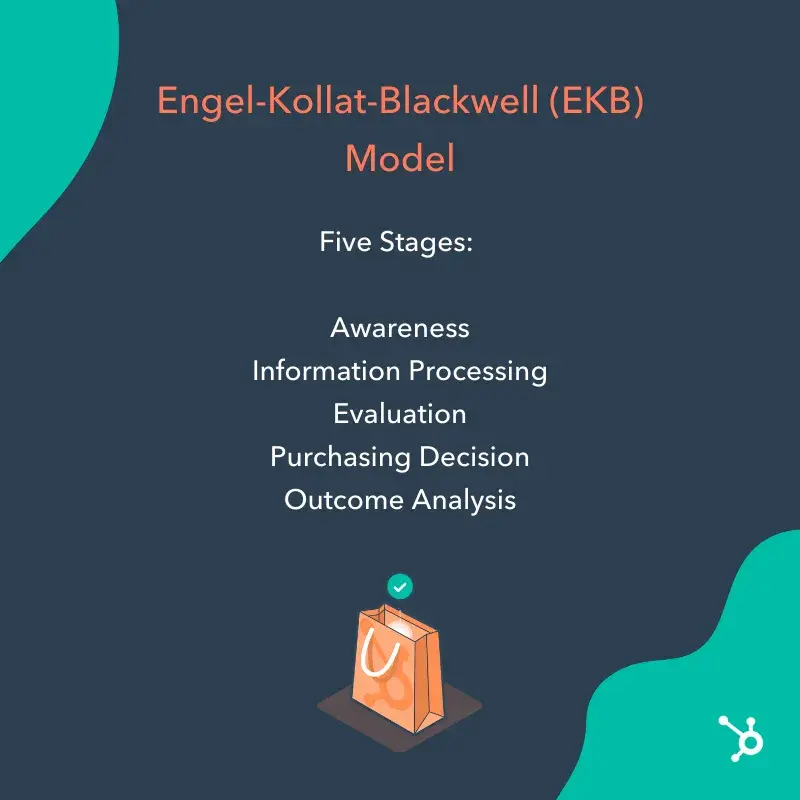
The Engel-Kollat-Blackwell model of consumer behavior outlines a five-stage decision process. Let’s check out the stages:
1. AwarenessWhat is it? The beginning of the decision-making process when a consumer recognizes they have a need or problem that requires a solution.
Example. My new apartment has a back patio (a first for me in NYC), and I realized I wanted to furnish it with an outdoor sectional.
2. Information ProcessingWhat is it? After recognizing the problem, the consumer begins gathering information about possible solutions. This can include internal searches (recalling from memory) and external searches (internet, reviews, friends).
Example. I called my parents and asked about their sectional (apparently, you have to cover it when it rains), browsed Pinterest for patio inspiration, and Googled “best outdoor sectional reddit” to see what the internet had to say about it.
3. EvaluationWhat is it? Once the consumer has gathered enough information, they compare different options based on factors like price, features, and personal preferences.
Example. After intensive research, I narrowed it down to a rattan couch from Walmart and a teak one from Wayfair. The Walmart couch was larger, cheaper, and featured a lift-top coffee table, but the teak one better fit my vision for a Japanese Zen Garden theme — tough choice.
4. Purchasing DecisionWhat is it? The moment of truth when the consumer decides to buy the product or service. Factors like availability, advertising, brand loyalty, or word-of-mouth could influence the purchase decision.
Example. I bought the teak one from Wayfair. It was a little more expensive, but I preferred the aesthetic, and it was my girlfriend’s favorite.
5. Outcome AnalysisWhat is it? Post-purchase, the customer evaluates their level of satisfaction with the product. If they are happy with the purchase, they may become brand loyalists and choose to make repeat purchases with the brand. If unsatisfied with the product, they might leave negative feedback and avoid the brand in the future.
Example. I’ll have to let you know. The couch hasn’t arrived yet. But, if it’s comfortable and looks as good as it does in pictures, I’ll be happy, and I’ll certainly recommend Wayfair to friends and family.
Does this model apply to your business?
Do the steps of this model seem familiar? They should! The EKB model echoes the Buyer’s Journey, which outlines the buyer’s process of becoming aware of a problem, considering the options, and deciding to purchase.
Awareness of the buyer’s journey and EKB model can benefit any business when positioning its product in the market. Provide ample information and reviews to support the information processing and evaluation stages, and most importantly, try to shift your mindset from selling products to helping people solve problems.
2. Black Box Model of Consumer Behavior
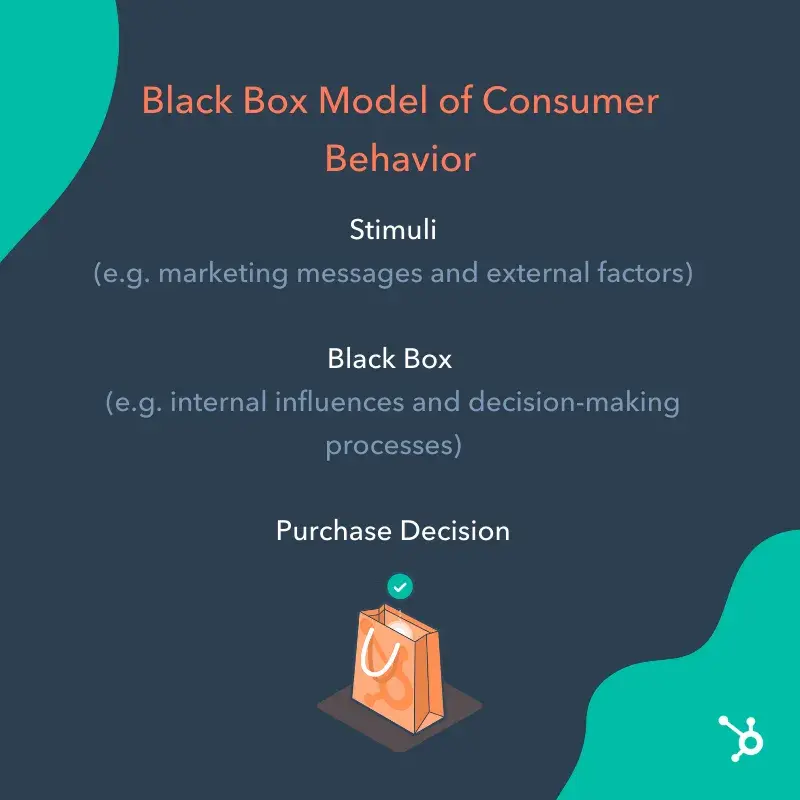
The Black Box Model of Consumer Behavior is a conceptual framework focusing on understanding the relationship between external stimuli and consumers’ observable actions.
The model gets its name from the idea of a Black Box representing a consumer’s mind, where internal thought processes aren’t directly observable. Since we can never fully know what happens in the buyer’s mind, the black box model seeks to infer the decision-making process by analyzing the consumer response (purchasing or not) in relation to observable external stimuli.
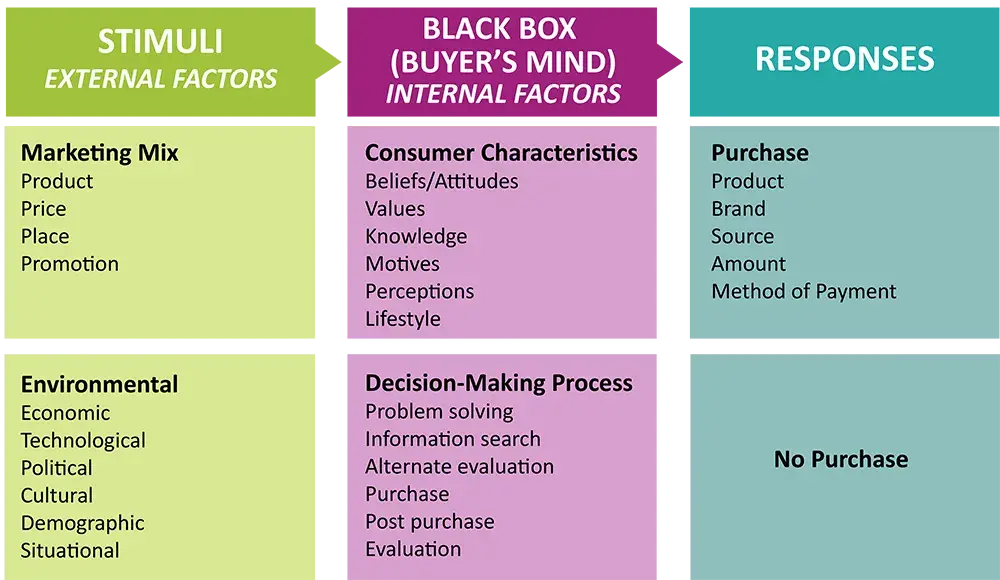
External stimuli that influence the decision-making process are separated into two categories: the marketing mix and environmental stimuli.
Marketing Mix
The marketing mix is external stimuli a company creates to influence a purchasing decision within the black box.
- Product. The features, quality, design, and packaging of the product.
- Price. How much the product costs, including discounts or promotions.
- Place. Where the product is available (online, in-store).
- Promotion. Advertising, social media, and all forms of direct marketing meant to inform the consumer.
Environmental Stimuli
Environmental stimuli result from the buyer's life circumstances and society and cannot be controlled by the company.
- Economic. Income, employment status, overall economic environment.
- Technological. Technological advancements that affect product innovation and information access.
- Political. Government regulations, taxes, and policies.
- Cultural. Cultural values and norms that influence preferences and behavior.
- Demographic. Age, gender, education, location, and more.
- Situational. Special occasions, time constraints, physical setting, and emotional state.
Inside the black box (the mind), the consumer weighs all external stimuli based on past experiences, preferences, beliefs, and values and produces an output (a purchase decision).
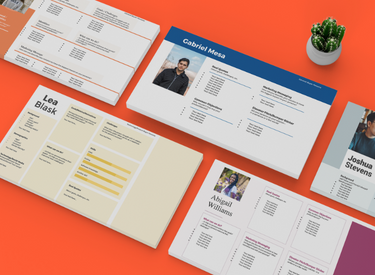
Buyer Persona Templates
Organize your audience segments and make your marketing stronger.
- Learn about personas.
- Conduct persona research.
- Create targeted content.
- Build your own personas.
Download Free
All fields are required.

Example
Right now, I’m on tour with my band, driving from New York to Omaha, NE, for the first show of our tour. Naturally, I spend a lot of time at gas stations and rest stops on the road. This morning, I bought a Barebells protein bar as a healthy snack. The design of the packaging and quality of the bar (Product), the two-for-$5 deal (Price), and the convenient availability at Love’s Travel Stops (Place) played into my purchase decision.
These external stimuli entered my black box (mind), where I considered my past experiences with the protein bar. Specifically, I know the bar tastes good, and I’ve purchased it before at my gym. These external stimuli, combined with my preferences, experiences, and need for a quick, healthy snack, led me to purchase it.
This simple purchase illustrates the basics of the Black Box model, in which we’re influenced by external stimuli but ultimately guided by our internal thoughts and experiences when making a purchase.
Does this model apply to your business?
The Black Box Model of Consumer Behavior offers a valuable framework for understanding and influencing consumer purchasing behavior. It can benefit lifestyle brands that gather detailed consumer information and target marketing messaging accordingly.
3. Hawkins Stern Impulse Buying Model
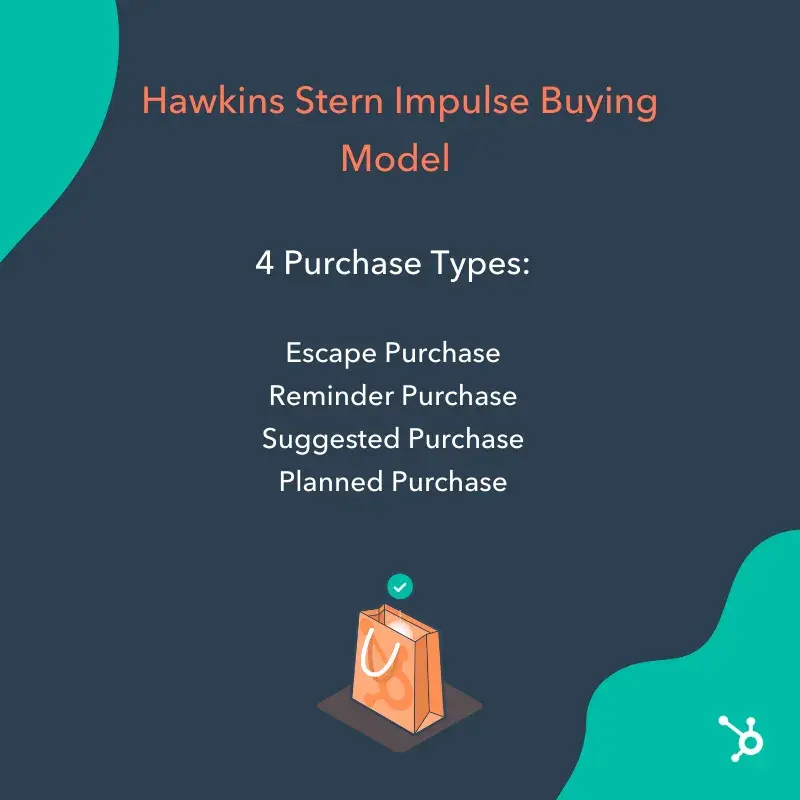
Unlike other models of consumer behavior, the Hawkins Stern Model suggests that not all purchases result from rational thought processes. Instead, many are impulse purchases driven by sudden, powerful urges to buy something immediately, often triggered by external stimuli. I’ve been there, and I’m sure you have, too.
This model categorizes impulse buying into four types:
1. Escape Purchase (Pure Impulse Buying)What is it? A classic, unplanned purchase that breaks a typical buying pattern and is often driven by emotions.
Example. My girlfriend and I were walking around Williamsburg on the way to a dinner reservation when we passed Bon-Bon, a specialty Swedish candy store. We weren’t planning on having a candy appetizer, but we bought $15 worth of gummies because they just looked so good!
2. Reminder PurchaseWhat is it? When consumers see a product and are reminded they need it.
Example. I was at the grocery store the other day when I saw the paper towels and remembered I needed to pick some up.
3. Suggested PurchaseWhat is it? An impulse purchase that occurs when a consumer is made aware of a product by an advertisement or in-store salesperson.
Example. I bought a water bottle at a bodega in Brooklyn the other day. The cashier was ringing me up when his daughter, standing to his right, asked me, “Do you want to try my homemade banana bread?” How could I say no? I bought the banana bread, too.
4. Planned PurchaseWhat is it? When a consumer goes shopping with a specific purchase in mind but is open to other items if there are good deals.
Example. This happens to me all the time when I shop for clothes. I’ll go on a website looking to buy a pair of jeans, and the next thing I know, I’ve loaded up my shopping cart with four shirts on top of that because they were on sale. It’s basically free! At least, that’s what I tell myself.
Does this model apply to your business?
The Hawkins Stern Model applies to most businesses, especially in ecommerce and retail. Humans are emotional and visual creatures, and nearly any business can take advantage of that and create an impulse-buying scenario.
Tips for Leveraging the Hawkins Stern Impulse Buying Model
1. Strategic Product Placement- Place impulse items near checkout areas and high-traffic zones.
- Showcase featured products with eye-catching displays (both in-store and on your site).
- Create urgency with time-sensitive promotions.
- Offer flash sales or exclusive deals.
- Offer discounts for bundles of related items.
- Suggest complementary products during checkout.
- Use data to suggest products based on browsing history.
- Send targeted emails with personalized product suggestions.
4. Howard Sheth Model of Buying Behavior
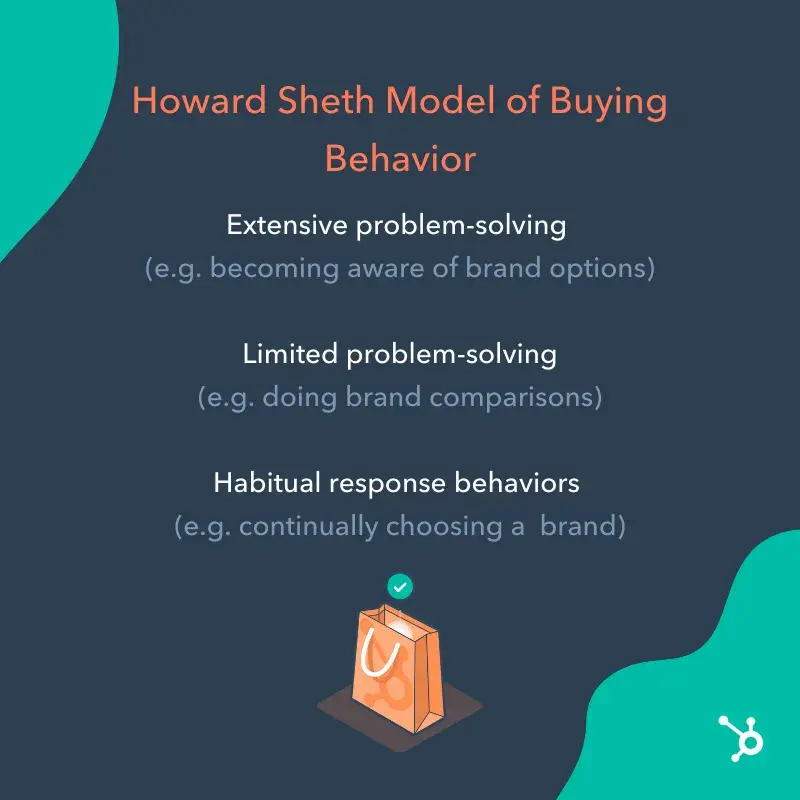
The Howard Sheth Model of Buying Behavior can be thought of as the opposite of the Hawkins Stern Model. It is a framework for understanding high-involvement purchases, where customers invest significant time and effort in making informed, rational, and systematic decisions.
The Howard Sheth model postulates that purchase decisions can be categorized into three levels, differentiated by the amount of consumer knowledge:
1. Extensive Problem-Solving
- Consumers have little to no prior knowledge or experience with a product or brand.
- Consumers invest significant time and effort into gathering information and researching options.
Example
As I mentioned previously, I just moved into a new apartment. I live in Brooklyn, and if you don’t know, the NYC rental market is CRAZY. I actually do have prior experience renting in NYC. However, my apartment hunt falls into the extensive problem-solving category due to the significant time and effort I invested in the process.
I searched StreetEasy and other apartment apps daily for nearly two months, researched multiple neighborhoods, and viewed upwards of 20 apartments before finally finding an acceptable place to rest my head.
The stakes are high when it comes to securing affordable and decent housing in NYC’s competitive market, which necessitated a complex decision-making process that required a high level of involvement, significant risk, and comprehensive information gathering.
2. Limited Problem-Solving
- Consumers have some prior knowledge or experience with a product or brand.
- The purchase decision requires moderate time and effort.
- Consumers rely on both past experiences and new information gleaned from research.
Example
I’m a professional bassist in a touring band, and as is unfortunately, a rite of passage for many seasoned road warriors, someone broke into our van last summer and stole our gear, including my bass amp.
Faced with the need to replace my amp, I conducted a moderate amount of research. I’ve been playing bass for many years, so I know a decent amount about bass amps. However, I never had loyalty to one particular brand and didn’t feel the need to mindlessly buy the same model that I lost.
I knew what kind of amp I was looking for, and I quickly narrowed it down to a few options by drawing on my past knowledge and experience. Ultimately, I settled on a new amp from an alternative brand that was more powerful than my old one and offered some nice additional features.
3. Habitual Response Behavior
- Consumers have significant experience with a product and are likely to show brand loyalty.
- The purchase decision is habitual and requires little effort and consideration.
Example
When I visit my parents in New Jersey, there’s only one coffee shop I go to: Turnstile Coffee Roasters. Our family has significant experience with this coffee shop — and coffee in general. Since it opened, Turnstile beans are the only beans you’ll find in our household. Whenever we need a refill, the decision to head to Turnstile is automatic.
We keep returning to Turnstile because the quality is exceptional, the beans are roasted in-house, and the staff is friendly. Over the years, we’ve built such strong trust in their brand that we don’t even consider other options. At this point, buying beans from Turnstile is habitual and demonstrates our significant brand loyalty.
The Howard Sheth model combines these three decision-making stages with other components to explain consumer behavior:
- Input Variables. Marketing messaging and environmental influences from friends, family, and culture.
- Perceptual and Learning Constructs. The consumer’s internal psychological variables influencing a purchase decision. Consumers' perceptions, attitudes, and learning modify how they receive and understand input variables.
- Output Variables. The consumer’s response to input variables and perceptual and learning constructs, i.e., the purchase decision and post-purchase behavior.
Does this model apply to your business?
The Howard Sheth model of consumer behavior can be useful for understanding where customers are in the decision-making process and tailoring strategies accordingly.
Offering detailed content, such as blogs, whitepapers, and how-to guides, can assist consumers in the extensive problem-solving phase. You can target consumers in the limited problem-solving phase by simplifying their choices with comparison charts and quick guides and leveraging social proof with case studies, success stories, and user-generated content. Finally, you can maintain consumers' loyalty in the habitual response stage with loyalty programs, personalized outreach, and ongoing high-quality support.
5. Nicosia Model of Consumer Behavior
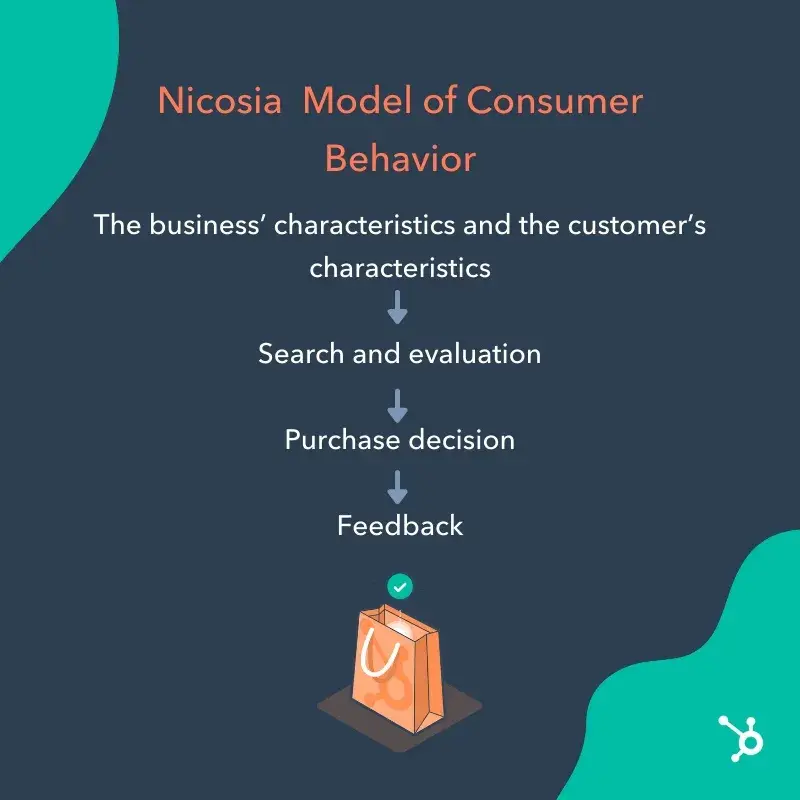
The Nicosia Model of Consumer Behavior is a framework for understanding purchasing decisions by focusing on the relationship between the company and the consumer. Unlike other models that emphasize consumers' internal thought processes and preferences, the Nicosia model favors the perspective of the business and the effectiveness of its marketing messages.
The model is divided into four fields, each representing a different stage of the interaction between the consumer and the business.
Field One: The Business’ Characteristics and the Consumers' Characteristics
The first field represents the transfer of information from the business to the consumer. It is further divided into two subfields.
- Subfield One. The business develops its marketing messaging to influence the consumer.
- Subfield Two. The consumer receives the marketing information and begins to form an attitude towards the company and product based on this information and environmental/personality factors.
Example: I recently encountered an Instagram ad for an extra-grippy phone case. The ad featured an endorsement by famous tech reviewer MKBHD, which led me to form the attitude that it was a top-of-the-line product from a cutting-edge brand.
Field Two: Search and Evaluation
- Having formed an initial attitude towards a company, the consumer begins to search for more information on the brand and its products and evaluate them based on their needs and preferences.
- Consumers will also compare alternative options from other brands.
Example: I clicked through the ad and visited the company’s website. I searched their available cases and found one that fit my iPhone 14 Pro. However, I wasn’t a massive fan of the colors they offered, and I didn’t think $59.99 was a great deal for a phone case.
Field Three: Purchase Decision
- The consumer decides whether to purchase the product, influenced by the attitudes formed in field one and the evaluation of field two.
Example: I decided not to purchase the phone case because of the price and colors, which didn’t align with my preferences.
Field Four: Feedback
- The company will evaluate the effectiveness of its marketing messaging and alter it accordingly.
- The consumer’s experience with the newly purchased product impacts their attitude toward the brand, influencing future purchase decisions.
Example: I didn’t buy the phone case, so that’s likely the end of the feedback loop between me and the company. If I had purchased the case and enjoyed it, that would have strengthened my positive attitude about the brand and perhaps led to another purchase in the future.
Does this model apply to your business?
The Nicosia Model applies to your business if you rely on marketing communication to reach and influence potential customers. Recognizing that consumers form an attitude towards your brand based on marketing communication is essential. This necessitates researching your target audience's needs, values, and preferences and developing marketing messaging that aligns with them.
6. Webster and Wind Model of Organizational Buying Behavior
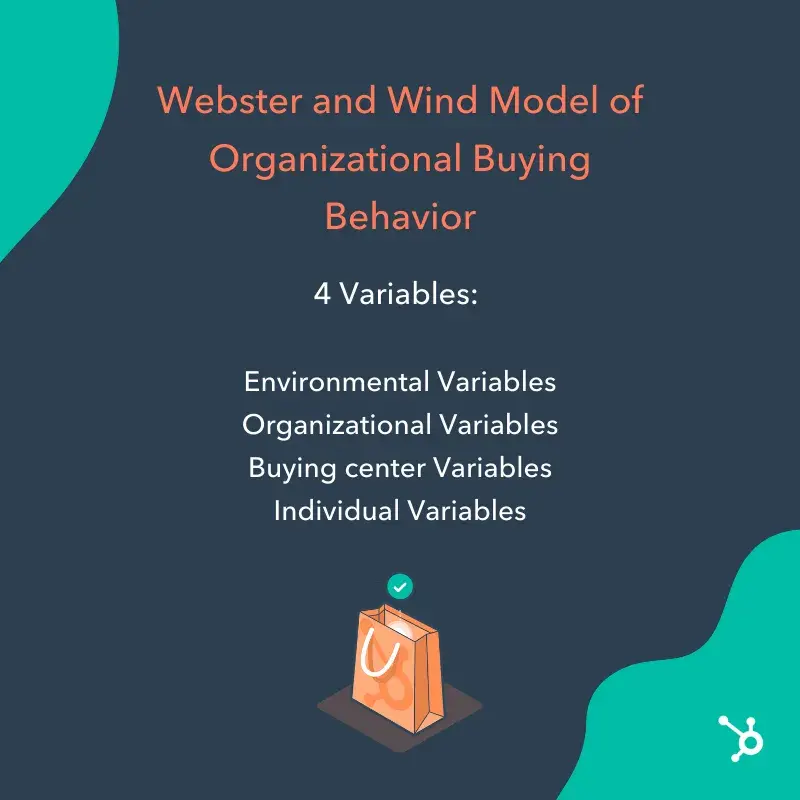
The Webster and Wind Model of Organizational Buying Behavior explains how companies buy products and services. B2B buying behavior differs from that of individual consumers in multiple ways. The main differences are as follows:
- Multiple Decision Makers. Multiple individuals and departments are involved in purchase decisions.
- Formal Processes. B2B purchases typically follow organized procedures and approval processes.
- Rational Evaluation. Purchases are assessed logically, and emotional factors are less likely to be considered.
The Webster and Wind model identifies four main categories of variables that affect B2B buying behavior:
1. Environmental Variables. These factors impact an organization's purchasing behavior but are outside its control.
- Economic. Market conditions and overall financial climate.
- Technological. Advances that could influence product needs.
- Political and Legal. Regulations, policies, and compliance.
- Cultural and Social. Societal expectations and industry norms.
- Competitive. Actions of competitors and industry trends.
2. Organizational Variables. Internal factors and goals that can influence purchasing behavior.
- Goals. Goals like cost reductions, innovation, or quality improvement.
- Structure. Organizational hierarchy and communication pathways.
- Policies and Procedures. Organizational guidelines for purchasing.
- Resources. Budget constraints and technological capabilities.
3. Buying Center Variables. All individuals and groups involved in a purchasing decision. Some of those roles include:
- Initiators recognize the need for a product or service.
- Users will use the product or service.
- Deciders are those with the authority to choose amongst options.
- Buyers handle the procurement process.
- Approvers authorize the actions of buyers and deciders.
- Gatekeepers control the flow of information.
4. Individual Variables. The personal characteristics of the individuals involved.
- Motivations. Goals, level of risk tolerance, and personal objectives.
- Perceptions. How they interpret information based on experience.
- Preferences and Attitudes. Bias towards certain brands or products.
- Demographics. Age, education, and professional background.
Example
As I mentioned earlier, I am a bassist in a touring band. Our band consists of seven individuals (six band members and one manager). Despite what you might think about being in a band, it’s an incorporated business, and our buying behavior reflects the Webster and Wind model. For example, we must create and purchase merchandise (clothing and vinyl) to sell at our shows whenever we go on tour.
The buying process for our merchandise is multi-step. It involves the approvals and input of every band member — everything from hiring the designer to choosing the t-shirt blank and deciding how much stock to purchase.
Recently, our organizational goal was to improve the quality of our merchandise designs, which influenced our decision to increase our design budget. Once the band (Approvers/Deciders) signs off on a merch design, our manager (Buyer) contacts our manufacturing partner to conduct the procurement process. In this case, I was the Initiator who raised the need for improved merch designs. I was also the Gatekeeper, as I took responsibility for finding potential designers and presenting options to the band.
Does this model apply to your business?
Absolutely. All businesses need to make purchases at some point, and the Webster and Wind model can help you understand your own purchasing choices and better appeal to B2B customers. You can leverage the Webster and Wind model to map out the buying center of potential customers, research organizational factors, and personalize your messaging to appeal to specific stakeholders at target companies.
Unlike personal purchase decisions, B2B buying is a more methodical process that must pass through multiple people, departments, and stages. That’s not to say business buying is completely impassive because, at the end of the day, companies are still run by people.
Choosing the Right Model for Your Business
Selecting the right consumer behavior model for your business may seem daunting, but in reality, there are takeaways from each model that you can use to improve your strategies. Having said that, certain models are more applicable than others for specific business types.
- Retail. Retail businesses can benefit from studying the Hawkins Stern model of consumer behavior since retail scenarios are the most common for customers to make impulse purchases. Ecommerce and online retailers can benefit strategically from this as well.
- Luxury. Luxury brands sell more than just products. They sell a lifestyle. As a result, I recommend for brands in the luxury space to pay close attention to the Psychoanalytical Model of consumer behavior to craft messages that appeal to the deep seated desires of customers.
- B2B. If you’re in the B2B space, the Webster and Wind model of consumer behavior is for you. B2B buying differs from individual consumer purchasing behavior, and this model can help you craft specific strategies for appealing and selling to other companies.
- SaaS. SaaS companies may benefit from understanding the EKB model of consumer behavior since it can illuminate the complex decision-making process a consumer undergoes, especially regarding intangible products.
Every consumer behavior model on this list is valuable in creating a holistic understanding of how and why your customers buy. There is no single right answer, so I recommend taking some knowledge model to craft a strategy that appeals to your customers’ specific needs, desires, and behaviors.
Need some help understanding your customers? Try creating a customer journey map to uncover the customer experience and figure out where to make improvements to your product, marketing, and service processes. Check out our template to help get you started.
Your Customers Will Inform Your Strategy
After my deep dive into consumer behavior models, I’ve come to the conclusion that it all comes back to the customer. Each consumer behavior model explains why customers buy for different reasons, but at the end of the day, having a strong sense of who your customers are and what they need will guide you.
Personally, I think the Sociological Model is crucial to understand in today’s marketplace, where consumers are easily influenced by their peers and content on social media. Platforms like Instagram and TikTok have turned everyday people into influential voices that guide purchasing decisions on a massive scale.
In essence, the customer should guide your approach, and each of these consumer behavior models will arm you with valuable strategies to appeal to them effectively. By applying these insights, you can craft messaging that resonates with consumers and develop lasting relationships.
Editor's note: This post was originally published in January 2021 and has been updated for comprehensiveness.
.webp)
Free Customer Journey Template
Outline your company's customer journey and experience with these 7 free templates.
- Buyer's Journey Template
- Future State Template
- Day-in-the-Life Template
- And more!
Download Free
All fields are required.
.webp)





